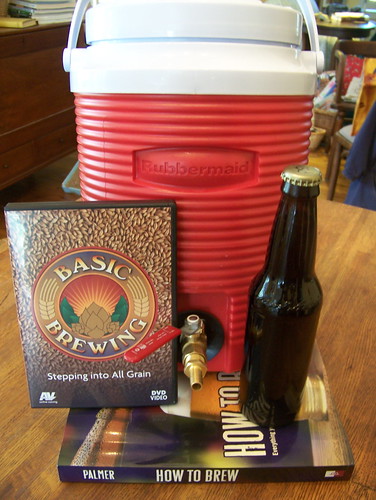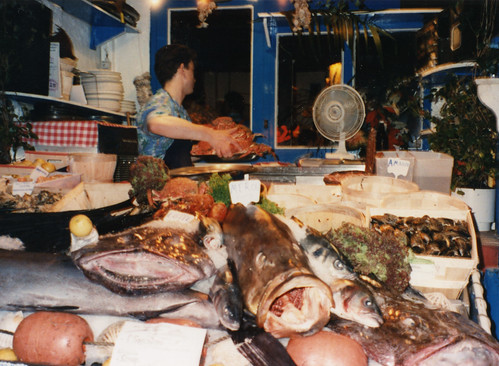Summary: Stepping into All Grain, a DVD produced by James Spencer and Steve Wilkes of Basic Brewing Radio and Basic Brewing Video, is an essential purchase for libraries building “how-to” collections on homebrewing, and a boon for any homebrewer even thinking about making the move to all-grain brewing or just interested in learning more about the process. The DVD, part of a series, is about $20 and can be purchased at local homebrew stores, through online resellers, and through Basicbrewing.com. Format: NTSC DVD Video. Length: approximately 60 minutes. No region encoding.
Review

Stepping Into All Grain
One of the dirty little secrets of any hobby is that beyond the alluring entry level, with its promise of simple access to a fun homespun craft, true expertise is hard-won, and generally involves more expense and stress than was initially anticipated the day the participant first mused, “Gee, it would be fun to [brew beer] [build a remote-controlled airplane] [raise miniature sheep].”
Many homebrewers avoid all-grain brewing because it seems complicated and spendy — far beyond the “fun” part of the hobby that first drew them in. Many might change their minds after viewing Stepping into All Grain. Even if the viewers don’t step into all-grain now or ever — and it would be hard not to after watching this DVD — they can at least become armchair all-grain brewers, stoked with the kind of knowledge to keep them looking smart on the many homebrewing bulletin boards and mailing lists, and pleasurably revisiting their fantasy hobby time and again. (Or like me, they could take one step forward, with countertop partial-mash brewing.)
The genius of Stepping into All Grain is twofold.
First, homebrewers interesting in all-grain brewing quickly encounter too much information from all directions. The beginners’ books on homebrewing are invaluable, and yet are not enough. Websites, chat rooms, and YouTube present information that is sometimes contradictory, incomplete, overly biased, or simply a sales pitch for equipment you might not need. Furthermore, cooking is an art where the techniques (if not the theory) are best taught visually, as is obvious from the wild popularity of television cooking shows.
Stepping into All Grain — targeted at the homebrewer familiar with extract or partial-mash brewing — expertly meets this need by boiling down a voluminous amount of information into seven tidy, well-produced chapters that hone in on exactly what a homebrewer needs to know to “step up” to all-grain.
This DVD understands its medium, balancing careful editing, expert close-ups of equipment, and frequent cuts to the narrators. It is one thing to read about fly sparging, and quite another to watch Spencer and Wilkes talk about sparge arms and hold one up, followed by a scene where a sparge arm spins water over a grain bed. One of the priceless low-tech moments on this DVD is when Spencer dips his fingers into a mash tun, tastes the liquid, and notes that it is now sweet. Oh right, I thought. Starch converting to sugar!
There are many sexy equipment close-ups. I was so inspired by the equipment chapter that last weekend I built a mini-mash-tun (after spending an embarrassing amount of time in the plumbing section of Home Depot mooning over brass and PVC fittings). I don’t have any intention of fly sparging… and yet, how I yearn for that sparge arm.

Spencer and Wilkes
But the narrators are crucial to this DVD as well. Smiling, affable, and garbed in nerdy business-casual while they stand in an enviously-clean “garage” or sit on a patio, Spencer and Wilkes — the Captain Kangaroo and Mr. Green Jeans of homebrewing — are calmly reassuring as they stir grain into mash tuns, calculate the amount of water needed for a brew session, drain the first runnings from a mash, heat up their strike water, explain vorlauf and lautering, or describe how they built their equipment.
Just as in their popular and information-packed podcasts and video blogs, Spencer and Wilkes never rush a scene; it is not criticism, but high praise, that after the first couple of times I viewed this video, I tripled the speed to run through some sections and could still clearly comprehend their comments.
(Spencer and Wilkes appear relaxed, but this DVD is very carefully produced. Though they promote themselves as just a couple of guys who like to brew, I learned from Spencer’s Twitter feed that he has a background in broadcast journalism. Spencer’s own media company, Active Voicing, produced this DVD. Wilkes has his own chops in the media world.)
The second bit of genius about Stepping into All Grain adroitly avoids competing dogmas about the “best” methods for all-grain brewing by offering alternatives throughout the DVD.
Whenever possible, Spencer and Wilkes begin with the simplest and least expensive alternatives, such as assembling a mash tun from two stacked brewing buckets (the top bucket drilled with holes), or fly sparging with a large Pyrex measuring cup. Then they move through other choices, such as using a round versus rectangular cooler for a mash tun.
There isn’t a best method; there’s just a method that will work for you right now — your time, your budget, your interest level, even your whims. I was very tempted by Wilkes’ choice of a garden faucet for his mash tun simply because it is creative and amusing, but I eventually chose a ball valve just because it felt right in my hands.
Though Stepping into All-Grain is carefully vendor-neutral, Spencer and Wilkes do show equipment for purchase such as false bottoms and sparge arms, and Spencer notes that even much of the “do-it-yourself” equipment shown in the DVD is available preassembled in local homebrew stores.

Mini-Mash Tun
(I admit that when Spencer held up a ball-valve assembly and noted that it could be purchased by people who weren’t “handy,” the former jet engine mechanic in me immediately decided to build one — and to one-up Spencer’s example by plugging the end of the straining hose and containing the jaggy edges, even though deep down I know that for the DVD’s sake he deliberately selected the simplest path.)
Furthermore, at two crucial points in the DVD — mashing and sparging — Stepping into All Grain offers alternate chapters for viewing the major techniques. This clever chaptering not only lets the viewer skip a technique she’s not presently interested in, but also becomes invaluable as a quickly-accessible reference to the flustered homebrewer standing over a mash tun and suddenly wondering, “Uh — exactly what was that next step, again?” (Yes, that would be me.)
The DVD “extras” section includes two recipes and the obligatory outtakes, which leads to my only criticism. Stepping into All Grain would have benefited from a small insert, such as a single 8.x5″x14″ sheet, folded twice, with a list of suggested parts for the equipment shown in the video, the two sample recipes with a little more information about why they were selected and what they will taste like when you’re done brewing, and a list of links and recommended books (and, crucially, references to Basic Brewing’s other DVDs and their store SWAG).
Such an insert would have been a useful reference not only for the individual brewer, but also for reviewers and librarians. Never underestimate the library market; a favorable review in a preferred review source such as Booklist, Video Librarian, or Library Journal can sell a lot of copies, particularly for books, DVDs, and other materials related to hobbies, do-it-yourself, and so forth. Make it easy for us to buy, catalog, and recommend your stuff.
In any event, at about $20 — or about half the price of a typical all-grain homebrew session, once you factor not just grain, hops, and yeast, but also equipment, supplies, energy, and water — this fun, useful DVD is a terrific value. Relax, don’t worry — buy Stepping into All Grain!













